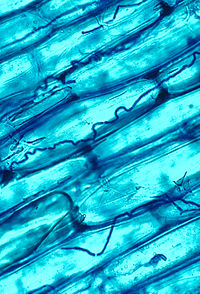
Photo from wikipedia
The spittlebugs Mahanarva spectabilis economically challenges cattle production of neotropical regions, due to its voracious feeding on tropical grasses. Here, we evaluated biochemical responses of the interaction between M. spectabilis… Click to show full abstract
The spittlebugs Mahanarva spectabilis economically challenges cattle production of neotropical regions, due to its voracious feeding on tropical grasses. Here, we evaluated biochemical responses of the interaction between M. spectabilis and the widely cultivated tropical grasses Brachiaria spp. (i.e., brizantha and decumbens) and elephant grasses (cvs. Roxo de Botucatu and Pioneiro), regarding lipoxygenases, protease inhibitors, phytohormones, and proteolytic activities in the midgut of M. spectabilis. The M. spectabilis-infested grasses increased lipoxygenases activity, except for cv. Pioneiro. The levels of the phytohormones jasmonic and abscisic acids were similarly low in all genotypes and increased under herbivory. Furthermore, salicylic acid concentration was constitutively higher in Brachiaria sp., increasing only in spittlebug-infested B. decumbens. M. spectabilis infestations did not induce increases of protease inhibitors in any forage grass type. The trypsin activity remained unaltered, and the total proteolytic activity increased only in B. decumbens-fed insects. Our findings revealed that most forage grasses exposed to spittlebugs activate the lipoxygenases pathway, resulting in increased abscisic and jasmonic acids. However, greater amounts of these hormones do not induce protease inhibitory activity in response to spittlebug attack. This knowledge certainly helps to guide future projects aiming at reducing the impact of spittlebugs on forage production.
Journal Title: Anais da Academia Brasileira de Ciencias
Year Published: 2021
Link to full text (if available)
Share on Social Media: Sign Up to like & get
recommendations!